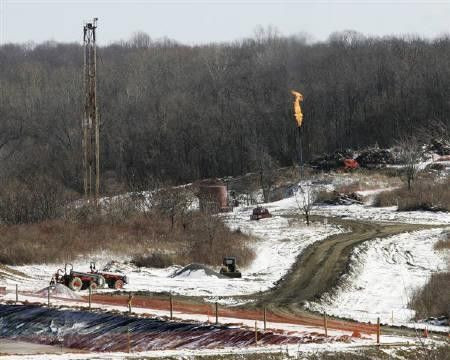Marcellus Shale to bring $250 bln to Pennsylvania

Marcellus Shale gas will bring an estimated $250 billion in payments to Pennsylvania land owners and stronger economic activity, said FBR Capital Markets.
The Marcellus Shale (also referred to as the Marcellus Formation) is a Middle Devonian-age black, low density, carbonaceous (organic rich) shale that occurs in the subsurface beneath much of Ohio, West Virginia, Pennsylvania and New York. Small areas of Maryland, Kentucky, Tennessee, and Virginia are also underlain by the Marcellus Shale.
"Marcellus Shale gas will bring an estimated $250 billion in payments to Pennsylvania land owners (more than four times the entire state's deposits) and drive $8 billion to $15 billion of annual spending in the state, based on 2,000 to 3,000 wells drilled per year," said Bob Ramsey, an analyst at FBR Capital.
Ramsey said gas companies spend $4 million to $5 million per well for site construction and preparation, casing and drilling of wells, transportation of materials to well sites, water and waste management, and restoration of sites, in addition to $1 million per mile of gas pipeline.
Ramsey said the estimated addition of 200,000+ jobs and growth in population have favorable implications for both housing and employment. Anecdotally, in areas with significant drilling activity, hotel rooms are booked for months (if not years), commercial real estate vacancies are declining, manufacturing activity is improving, and car and truck sales are strengthening.
Ramsey said this increase in economic activity has favorable implications for banks in terms of wealth management, deposits, and lending and makes acquisition of certain companies more attractive.
"Given the size of this opportunity, we have taken a closer look at which banks have the greatest exposure to the shale, strategies that banks are employing, and initial benefits to banks from shale activity," said Ramsey.
Direct Beneficiaries
Ramsey said the most significant direct beneficiaries are: Northwest Bancshares, Inc. (NWBI), FNB Corp. (FNB), First Commonwealth Financial Corp. (FCF), and S&T Bancorp Inc. (STBA)
FBR has created a proprietary "shale impact rating" incorporating county deposit market share, the level of drilling activity by county, and the overall proportion of deposits in counties with shale, such that banks with significant market share in counties with a large number of wells score the highest.
Of banks with a market cap over $200 million, Northwest Bancorp and FNB Corp. rank the highest, with respective ratings of 334 and 322 and 96 percent and 63 percent of total respective deposits located in counties with drilling activity. First Commonwealth ranks third with a score of 218, and S&T Bancorp ranks fourth with a score of 172. These four banks have the greatest opportunity to benefit from shale-related economic activity.
Sizable Opportunity for Wealth Management
Ramsey said Fulton Financial Corp. (FULT), Susquehanna Bancshares, Inc. (SUSQ), and National Penn Bancshares Inc. (NPBC) has a sizable opportunity for wealth management. Given that an estimated $250 billion will be paid to Pennsylvania landowners, gas extraction will create significant wealth in the state.
As much of this wealth is newly created and the recipients may not have established relationships, this is a large opportunity for companies with a focused strategy. Ramsey considers Fulton, Susquehanna, and National Penn well positioned from a wealth management perspective.
Marcellus Shale Exposure to be Catalyst for M&A
Ramsey said possible M&A (mergers and acquisitions) targets include Citizens & Northern Corp. (CZNC), Citizens Financial Services, Peoples Financial Services Corp., Penns Woods Bancorp Inc. (PWOD), and S&T Bancorp.
FNB described Marcellus Shale as one reason for its recent acquisition of Comm Bancorp and has expressed interest in deals near Pittsburgh, an area of significant shale opportunity. Ramsey expects that Marcellus Shale exposure will be a catalyst for M&A, and ranked banks with $500 million to $5 billion in total assets by his shale impact rating.
Ramsey said Citizens & Northern and Citizens Financial Services rank the highest, followed by Peoples Financial Services, Penns Woods Bancorp, and S&T Bancorp.
Payments to Landowners Reflected in Deposit Growth
In 2009, gas companies paid $1.7 billion to Pennsylvania landowners, and payments are estimated to total $250 billion over time. In October, CBU noted "significant deposit growth" in Northeastern Pennsylvania markets with drilling activity (through June 30, 2010, its Wyoming County year-over-year deposit growth was 25 percent compared with 2.7 percent in 2009).
Similarly, FNB attributed the inflow of deposits at its fastest-growing branch in January entirely to shale activity. Ramsey examined recent deposit growth in the five counties with the most drilling, which has outpaced the rest of Pennsylvania since 2007 (6.7 percent in 2010 versus 3.1 percent). Ramsey examined accelerated deposit growth trends from the Barnett and Haynesville shales.
Total shale-related spending is expected to grow from $4.5 billion in 2009 to $11.0 billion in 2011). Today, there are just over 2,300 wells drilled, and it is estimated that an additional 2,200 wells will be drilled in 2011 and more in subsequent years. Extraction, and the associated royalty payments to landowners, will take decades.
© Copyright IBTimes 2025. All rights reserved.





















